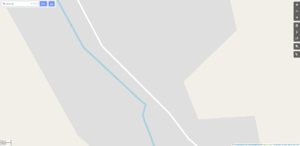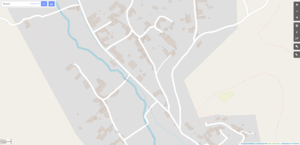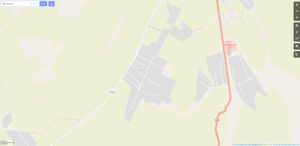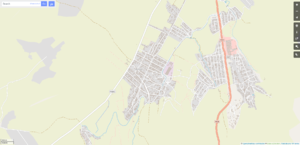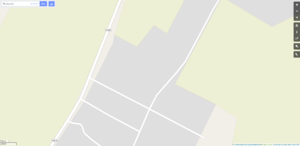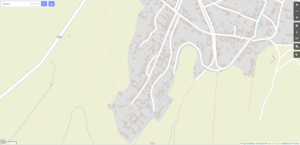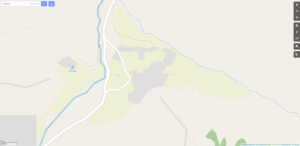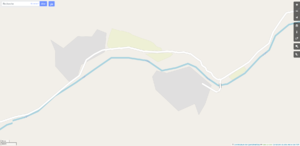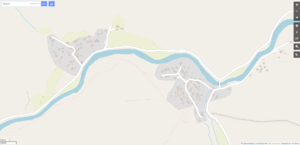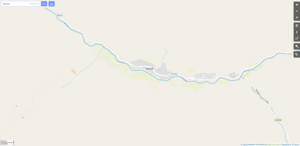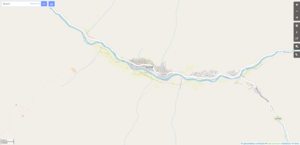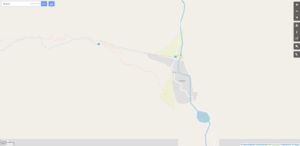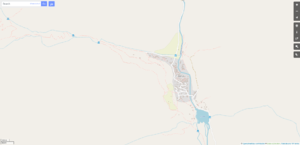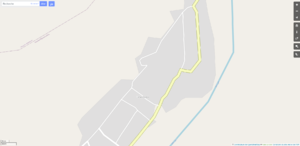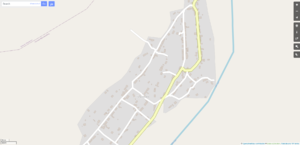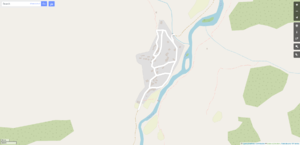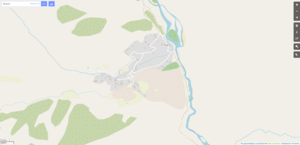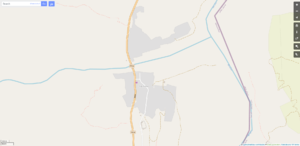Tajikistan/Participatory mapping in Tajikistan
The project “Participatory Mapping in Tajikistan” is aimed to strengthen climate change adaptation measures in rural Tajikistan using geographical information, technology, community-based approach and cooperation of various stakeholders.
It is expected to foster the creation, access and usage of geographical information and maps in Tajikistan's regions that are the most vulnerable to natural disasters. As way to address those challenges, we are in the process of creating a wider, thriving voluntary-based open-mappers community using the extensive ecosystem of tools of OpenStreetMap. The center of the innovative approach of the project is transparency, well-coordinated teamwork and flexibility of solutions for more effective achievement of the main goals.
While our project explicitly focuses on creating maps and data for supporting adaptation to climate change in remote rural communities of Tajikistan, our approach and skills can be extended to any other relevant areas, from tourism to water management, from public transportation to environmental awareness.
The slogan of the project is "Let’s create an OSM Community in Tajikistan together!"
This pilot project (implementation period from 01.02.2021 to 31.01.2022) is supported by the project "Technology Based Adaptation to Climate Change in Rural Tajikistan and Kyrgyzstan", implemented by GIZ on behalf of the German government and is jointly implemented by Little Earth (Tajikistan) and CartONG (France). Other close implementation partners are the Design and Research Institute FAZO, Aga Khan Agency for Habitat and the Red Crescent Society of Tajikistan. Potential stakeholders and groups of interest are State Ministries and Agencies, civil society, local communities, national and international mapping volunteers, International Agencies, Humanitarian organizations, Universities, tourist guides and other business representatives.
News
All announcements are currently published on the project's Facebook page. Please join us!
Context
How many people live in the flood zone? Which roads could be taken to deliver humanitarian aid to a village affected by a disaster, if its main access road was destroyed? Which safe places could be chosen as shelters for a community after a disaster stroke? What is the current extent of glaciers and mountain lakes? Which communities would be cut out from the outside world, if a landslide or an avalanche were to occur at a specific location?
All those questions cannot be addressed without maps. In Tajikistan however, most maps are outdated or are not publicly accessible.
Expected outcomes
- To create, formalize and raise the capacities of an OpenStreetMap community in Tajikistan, that will be able to support community-based mapping activities throughout the country;
- To contribute to the detailed mapping of selected remote villages in mountainous regions of Tajikistan through participatory mapping to improve the sustainable and climate-resilient development of local communities;
- To promote fruitful dialogues around the topics of community-based mapping between various stakeholders involved in climate change adaptation, disaster risk reduction, food security, and humanitarian aid;
- To ensure the open access of all collected data and respects the needs and standards of the National Spatial Data Infrastructure.
Achievements
Here below a few examples of villages that have been mapped during the project, while building up the OSM Tajikistan community.
(please click on the pictures to see in high-resolution)
| Place | Before the project | After the (remote) base mapping |
|---|---|---|
| Artuch | ||
| Madovra (Western part of Artuch) | ||
| Yakkakhona (Southern part of Artuch) | ||
| Lohur | ||
| Lohur (northern part) | ||
| Lohur (southern part) | ||
| Ghazza | ||
| Tavish | ||
| Tavish-i-bolo | ||
| Anzob | ||
| Padrud | ||
| Chil Dukhtaron | ||
| Hakimi | ||
| Labidjui | ||
| Khirmanjo |
Organised editing activity overview
List of HOT Tasking Manager projects:
Other activities:
We are training our volunteers for Field data collection (OSMand and Field Papers) in Dushanbe (adding and updating POI) and in the project villages.
Data quality control and contribution tracking in OSM
Little Earth is maintaining extra steps to the data contribution and validation process. Once the validation is 100% completed, we proceed to a remote global validation of the entire project area. This additional step allows us to homogenize the data & tagging and to better organize the different elements that have been mapped, above all the road and hydrographic networks.
After it is done and when possible, we proceed to a field validation of the project's villages.
Little Earth uses the changeset comments #LittleEarth #Tajikistan and #missingmaps in order to track the edits.
Re-use of the mapped data
The latest data are regularly shared on the Geoportal of the Tajik National Spatial Data Infrastructure, in order to make them easily available to any GIS user. The data are shared there under OSM's license terms.
Contact information
For any question on the project's activities in OpenStreetMap, in particular regarding an Organised Editing activity or if you try to contact a specific contributor linked to us and don't get a fast answer, please contact us (Little Earth).
Mapathons
In order to establish an OSM Community in Dushanbe the Little Earth organizes mapping events (mapathons) to gather interested people to fill the missing maps of mountainous Tajik villages. The participants learn how to work with satellite imagery and add new features to the maps. Volunteers also practice baseline mapping and tagging through field mobile data collection.
Main mappers active in the frame of this project
| OSM username | Role |
|---|---|
| Natalia Idrisova | Project Manager |
| Anton Timoshenko | Project Manager |
| shenriod | Project Manager |
| anisa_rock | Project Manager |
| Léonie Miège | Project Manager |
| naranjasol | Project Manager |
| IAMALISHER | Validator |
| siavash_f | Validator |
| SHODIBEK_12 | Validator |
| Zarrina9 | Validator |
| DiyorADDI | Validator |
Statistics of the mappers can be viewed on OSMstats - Tajikistan.
Outputs & end of the project
In the last 12 months of implementation (February 2021 - February 2022), Little Earth - with support from CartONG - has conducted extensive participatory mapping activities remotely and in selected project regions.
Core activities of the project :
Mapping phase
The mapping process consisted of mainly 2 phases:
1.1. Remote Mapping:
Through the organization of mapathons, where the most prominent features such as buildings, roads and rivers were traced on top of satellite or drone imagery; with a validation phase, where the quality of the mapping process, as well as the consistency of the data were checked and improved by more advanced mappers.
In total :
- 160 vulnerable villages have been mapped in the course of the project (60% of them within the project regions). To spatially visualize what has been mapped, a uMap has been created.
- 22 on-site mapathons in Dushanbe, 11 online mapathons and 11 validation sessions were organized.
1.2. Field Work:
Where additional information relating to disaster risk preparedness and response were collected that could not be identified from the imagery (localisation of schools and health points, passability of the roads, etc.). This local knowledge was gathered via another type of participatory mapping, using OsmAnd, a dedicated digital data collection application, and FieldPapers, specially designed sheet of papers for data collection, in order to streamline the later integration into the OpenStreetMap database.
In total :
- 5 villages were mapped: Shing, Panjrud, Merghuzor and Padrud in Penjikent district, and Romit in Vahdat district.
- 6 field data collection trainings were organized.
Engaging local communities on climate change issues
The field work also comprised workshops on awareness raising on climate change, and appropriate adaptation measures discussion through a subjective mapping exercise, another type of participatory mapping approach. Communities, split into two groups based on gender, were asked to draw on a big sheet of paper a map of their village and identify the places or livelihoods – either current or from the past – that are most at risk or that have been affected by natural disasters or climate change. This workshop aimed at taking into account gender as a factor in how climate change might be interpreted at a local level. Based on the subjective maps, discussion was then conducted on ideas of potential adaptation measures.
By engaging the local communities in the reflection and decision process, it helps to come up with a more comprehensive analysis of disaster risk reduction and climate change adaptation stakes in the target areas. It also ensures that the adaptation measures that will be implemented will be more efficient and adapted to the communities’ needs.
From data collection to data visualization and data sharing
Data collection in itself can only do very little for climate change adaptation. Only when it is shown or visualized in an appropriate way can it be used to trigger discussions and action. Therefore, two types of final products were produced. After the data integration and validation process, big-size printed maps of the villages were created and handed over to the local authorities and stakeholders that were visited during field work.
Raw data was also published on the National Spatial Data Infrastructure of the Republic of Tajikistan, so it is in free access to all interested parties, including government bodies, local authorities, organizations and citizens.
Our team has also trained and certified a group of active mappers and validators who have become a pillar for the formation of the OSM community in Tajikistan. What’s more, as a result of productive networking, the OSM Tajikistan community recently became an active member of the Open Mapping Hub-Asia Pacific which provides additional support for the thriving voluntary-based OSM community.
Strengthening the OSM Tajikistan Community
Consistency of the mapping events and trainings helped to build a team of core mappers to the community. The project team also managed to hold a number of meetings and consultations with international organizations, local companies and NGOs, researchers, and volunteers on the usage of OSM in their own framework of activity, thus contributing to the structuring of a locally informed stakeholders ecosystem. For instance, this project brought a Mapping Club to life, the latter is still meeting every week at the American Space in Dushanbe. We also have had the opportunity to work closely with the German Red Cross, currently operating in Tajikistan.
Additionally, in an endeavour to share our experience and the expertise acquired in applying participatory methodologies, our team has also actively participated in different thematic summits and conferences in the past few months, including GISCA, Hot Summit 2021 (you can watch the recording of the session here), AGSE, GIZ LandHub and the 2021 ICRC Analysis & Evidence Week Conference.
Thanks to this capacity-building and awareness-raising work, the project team strongly believes that the OSM community in Tajikistan will have many significant opportunities and projects in the future.





